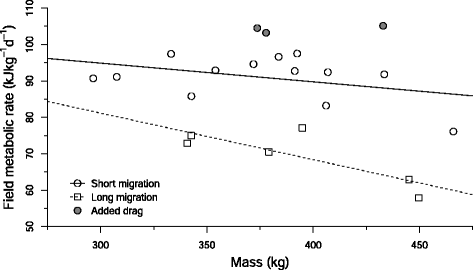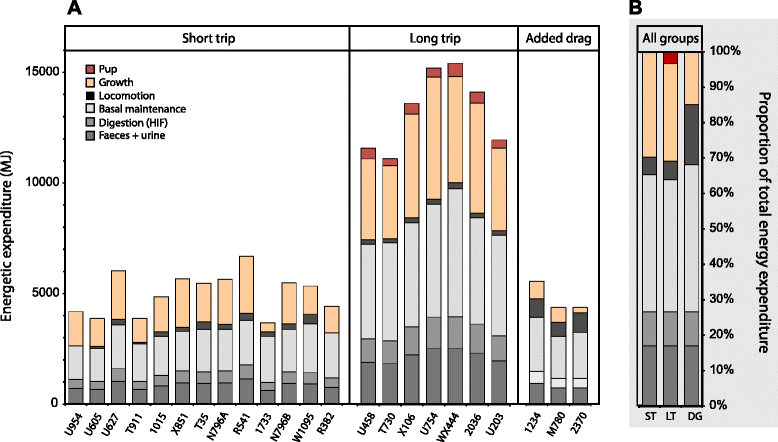Summing the strokes: energy economy in northern elephant seals during large-scale foraging migrations
- PMID: 26380090
- PMCID: PMC4570705
- DOI: 10.1186/s40462-015-0049-2
Summing the strokes: energy economy in northern elephant seals during large-scale foraging migrations
Abstract
Background: The energy requirements of free-ranging marine mammals are challenging to measure due to cryptic and far-ranging feeding habits, but are important to quantify given the potential impacts of high-level predators on ecosystems. Given their large body size and carnivorous lifestyle, we would predict that northern elephant seals (Mirounga angustirostris) have elevated field metabolic rates (FMRs) that require high prey intake rates, especially during pregnancy. Disturbance associated with climate change or human activity is predicted to further elevate energy requirements due to an increase in locomotor costs required to accommodate a reduction in prey or time available to forage. In this study, we determined the FMRs, total energy requirements, and energy budgets of adult, female northern elephant seals. We also examined the impact of increased locomotor costs on foraging success in this species.
Results: Body size, time spent at sea and reproductive status strongly influenced FMR. During the short foraging migration, FMR averaged 90.1 (SE = 1.7) kJ kg(-1)d(-1) - only 36 % greater than predicted basal metabolic rate. During the long migration, when seals were pregnant, FMRs averaged 69.4 (±3.0) kJ kg(-1)d(-1) - values approaching those predicted to be necessary to support basal metabolism in mammals of this size. Low FMRs in pregnant seals were driven by hypometabolism coupled with a positive feedback loop between improving body condition and reduced flipper stroking frequency. In contrast, three additional seals carrying large, non-streamlined instrumentation saw a four-fold increase in energy partitioned toward locomotion, resulting in elevated FMRs and only half the mass gain of normally-swimming study animals.
Conclusions: These results highlight the importance of keeping locomotion costs low for successful foraging in this species. In preparation for lactation and two fasting periods with high demands on energy reserves, migrating elephant seals utilize an economical foraging strategy whereby energy savings from reduced locomotion costs are shuttled towards somatic growth and fetal gestation. Remarkably, the energy requirements of this species, particularly during pregnancy, are 70-80 % lower than expected for mammalian carnivores, approaching or even falling below values predicted to be necessary to support basal metabolism in mammals of this size.
Keywords: Accelerometer; Aerobic dive limit; Body size; Disturbance; Field metabolic rate; Foraging; Hypometabolism; Locomotion; Pregnancy.
Figures






Similar articles
-
Free-swimming northern elephant seals have low field metabolic rates that are sensitive to an increased cost of transport.J Exp Biol. 2014 May 1;217(Pt 9):1485-95. doi: 10.1242/jeb.094201. J Exp Biol. 2014. PMID: 24790099
-
Oxygen minimum zone: An important oceanographic habitat for deep-diving northern elephant seals, Mirounga angustirostris.Ecol Evol. 2017 Jul 3;7(16):6259-6270. doi: 10.1002/ece3.3202. eCollection 2017 Aug. Ecol Evol. 2017. PMID: 28861230 Free PMC article.
-
Estimating resource acquisition and at-sea body condition of a marine predator.J Anim Ecol. 2013 Nov;82(6):1300-15. doi: 10.1111/1365-2656.12102. Epub 2013 Jul 19. J Anim Ecol. 2013. PMID: 23869551 Free PMC article.
-
Locomotion and the Cost of Hunting in Large, Stealthy Marine Carnivores.Integr Comp Biol. 2015 Oct;55(4):673-82. doi: 10.1093/icb/icv025. Epub 2015 May 3. Integr Comp Biol. 2015. PMID: 25936358 Review.
-
Adiposity and fat metabolism during combined fasting and lactation in elephant seals.J Exp Biol. 2018 Mar 7;221(Pt Suppl 1):jeb161554. doi: 10.1242/jeb.161554. J Exp Biol. 2018. PMID: 29514892 Review.
Cited by
-
Metabolic trade-offs in tropical and subtropical marine mammals: unique maintenance and locomotion costs in West Indian manatees and Hawaiian monk seals.J Exp Biol. 2021 Aug 1;224(15):jeb237628. doi: 10.1242/jeb.237628. Epub 2021 Aug 6. J Exp Biol. 2021. PMID: 34357378 Free PMC article.
-
Activity budget and gut microbiota stability and flexibility across reproductive states in wild capuchin monkeys in a seasonal tropical dry forest.Anim Microbiome. 2023 Dec 15;5(1):63. doi: 10.1186/s42523-023-00280-6. Anim Microbiome. 2023. PMID: 38102711 Free PMC article.
-
Effects of disease on foraging behaviour and success in an individual free-ranging northern elephant seal.Conserv Physiol. 2023 May 25;11(1):coad034. doi: 10.1093/conphys/coad034. eCollection 2023. Conserv Physiol. 2023. PMID: 37250476 Free PMC article.
-
Proxies of energy expenditure for marine mammals: an experimental test of "the time trap".Sci Rep. 2017 Sep 18;7(1):11815. doi: 10.1038/s41598-017-11576-4. Sci Rep. 2017. PMID: 28924150 Free PMC article.
-
The foraging benefits of being fat in a highly migratory marine mammal.Proc Biol Sci. 2014 Dec 22;281(1797):20142120. doi: 10.1098/rspb.2014.2120. Proc Biol Sci. 2014. PMID: 25377461 Free PMC article.
References
-
- Bowen WD. Role of marine mammals in aquatic ecosystems. Mar Ecol Prog Ser. 1997;158:267–74. doi: 10.3354/meps158267. - DOI
-
- Reynolds JE., III . Marine mammal research: conservation beyond crisis. Baltimore, MD: JHU Press; 2005.
LinkOut - more resources
Full Text Sources
Other Literature Sources

